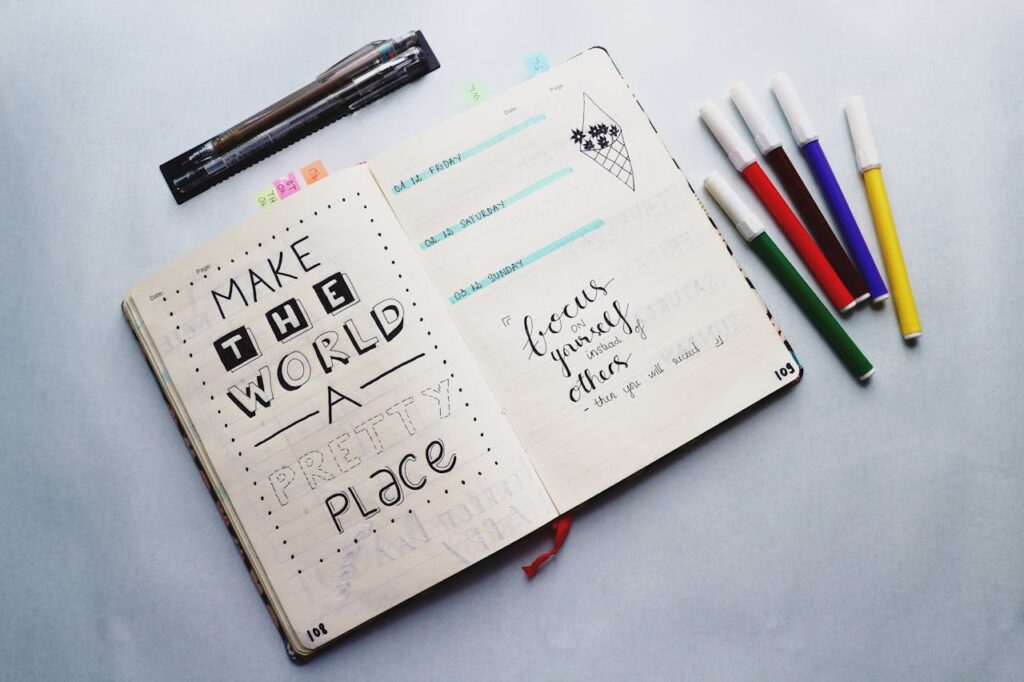
If your journal pages are starting to look the same, or you’ve been staring at a blank spread wondering how to make it yours, you’re in the right place.
The truth is, you don’t need to be an artist to design creative journaling layouts — just a curious mind, a pen, and a few layout ideas to spark inspiration.
In this post, we’ll explore practical and creative journaling layouts you can try today, whether you journal for mindfulness, productivity, or self-expression.
Why Creative Journaling Layouts Matter
Before we dive into examples, let’s talk about why layouts matter. A layout isn’t just decoration — it’s how you shape your thoughts on paper. A creative spread can:
- Make journaling more fun and engaging
- Help you organize your goals and reflections visually
- Boost motivation to open your notebook daily
Designing your pages with intention helps you see your ideas instead of just reading them. And that’s what makes journaling feel alive.
1. The Daily Log Spread (Creative Journaling Layout )
Let’s start simple. The daily log layout is the backbone of many journaling systems — especially bullet journaling.
Each day gets its own section where you jot quick notes, tasks, or reflections.
It’s clean, minimal, and effective.
How to use it:
- Write the date as your header.
- Add a few short sentences about your day, mood, or highlights.
- Leave a few lines for tomorrow’s goals.
This layout is great for beginners who want structure without overcomplication.
2. The Weekly Overview (Creative Journaling Layout)
A weekly layout gives you a big-picture view — perfect if you love planning and tracking habits.
Divide your spread into seven boxes or columns (one for each day). Add sections for:
- Priorities
- Appointments
- Gratitude
- Notes or doodles
This layout blends creativity and productivity seamlessly. You can even color-code your days for visual flair.
If you need help choosing tools for journaling, check out our post on journaling supplies you actually need to get started.
3. The Mood Tracker (Creative Journaling Layout)
One of the most popular creative journaling layouts is the mood tracker — a colorful and emotional snapshot of your month.
How it works:
- Create a grid, wheel, or simple calendar.
- Assign a color to each emotion (e.g., yellow for happy, blue for calm, gray for tired).
- Fill in one color each day to reflect your mood.
Over time, patterns emerge. You’ll notice what boosts or drains your energy.
You can find scientific insights about the link between mood tracking and mindfulness from Psychology Today.
Alt text: “creative journaling layout with colorful mood tracker in a circular design.”
4. The Habit Tracker
If you want to build consistency, a habit tracker layout is your secret weapon.
It turns progress into something visual and satisfying.
Draw a simple grid:
- List habits down the left side (e.g., drink water, read, stretch).
- Label days across the top.
- Check off each habit daily.
By the end of the month, you’ll see your progress in one glance — and trust me, those little checkmarks feel amazing.
Tip: Combine this layout with your daily journaling habit for better accountability.
5. The Gratitude Spread
Gratitude journaling isn’t new, but giving it structure can make it more meaningful.
A gratitude layout focuses your attention on what’s working in your life — not just what’s missing.
Layout ideas:
- Create a “3 things I’m grateful for” section for each day.
- Add small doodles or stickers to represent each gratitude item.
- Reflect weekly on recurring themes of joy or growth.
This layout works beautifully at the start or end of your journal.
Alt text: “creative journaling layout with gratitude log decorated with flowers and positive quotes.”
6. The Vision Board Page
Who says vision boards have to be digital? Bring your dreams to paper.
This creative journaling layout blends words, sketches, and clippings.
Steps:
- Set a theme (e.g., 2025 goals, personal growth, or creative dreams).
- Add quotes, affirmations, or images that inspire you.
- Leave space for updates or reflections.
If you love goal setting, this layout pairs perfectly with a future log or goal tracker.
You can learn more about setting achievable goals in our article on how to organize your journal effectively.
7. The Brain Dump Page
Sometimes creativity just needs space.
A brain dump layout is where structure takes a back seat.
Leave a page open for unfiltered thoughts, sketches, or lists.
This layout is perfect when your mind feels cluttered — it helps you release ideas and see what’s worth keeping.
Pair it with colored pens or washi tape to make it visually inviting.
8. The Monthly Reflection
A monthly reflection layout is where your journaling comes full circle.
It helps you look back, evaluate, and reset.
Include sections like:
- Highlights of the month
- Lessons learned
- What to improve next month
This layout keeps your journaling purposeful — not just pretty.
Alt text: “monthly reflection spread showing highlights, lessons, and creative journaling notes.”
Bonus: Mix and Match Your Creative Journaling Layouts
You don’t have to stick with one format. Combine ideas based on your needs:
- Daily log + habit tracker = balance
- Gratitude + mood tracker = mindfulness
- Brain dump + vision board = creativity boost
Experiment until your pages reflect you. There’s no “right” way — only what keeps you inspired.
Final Thoughts
The best creative journaling layouts aren’t about art or aesthetics — they’re about expression.
Start simple, stay consistent, and let your creativity evolve.
Each page you design is a small act of reflection and intention.
So grab your notebook, try one of these layouts today, and let your journal tell your story — beautifully, imperfectly, and authentically.
